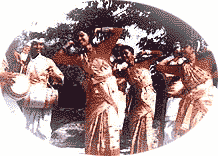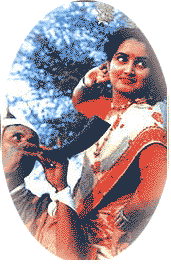| BIHU
FESTIVALS & RANGALI BIHU |
|
| Celebrated In
:
Assam |
|
| Significance :
National Festival of Assam |
|
| Types of Bihus
:
Bohag Bihu, Magh Bihu & Kati Bihu |
|
| Festivity
Dance :
Bihu |
|
|
|
| Bihu is the most important non-religious
festival of the Assamese people. People of this state observe it every year
irrespective of their class and caste.
|
|
It has been observed from time immemorial and
has been adjusting itself at different ages taking into consideration the
changed situation of a particular age.
The Bihus are the national festivals of Assam.
There are three such festivals in Assam: in the months of 'Bohaag' ('Baisakh',
the middle of April), 'Maagh' (the middle of January), and 'Kaati' ('Kartik',
the middle of October) |
 |
|
|
The Three
Bihus
Each Bihu coincides with a distinctive phase in the farming calendar. The
"Bohaag Bihu" marks the New Year at the advent of seeding time, the "Kaati
Bihu" marks the completion of sowing and transplanting of paddies, and the
"Maagh Bihu" marks the end of the harvesting period. Bohaag Bihu is also called
the "Rangali Bihu" or the Festival of Merriment, Magh Bihu is also called
"Bhogali Bihu" or the Festival of Food, and Kaati Bihu is also called "Kongaali
Bihu" or the Festival of the Poor
|
|
Bohaag Bihu
or Rangali Bihu
Of the three Bihu festivals, which are secular and non-religious, the Bohaag
Bihu ushers in the period of greatest enjoyment and marks the arrival of spring
season. The most important festival of the Sonowals is the Rangali Bihu, which
falls on the, 'Sankranti' of(or) 'Chot' (14th April) and continues for a
fortnight.
|
|
 |
Traditional Festival Of The
Sonawals
Like other Assamese people, the Sonowals, too
consider the Rangali Bihu as their traditional community festival. The main
trait of this Bihu is the dance of young boys and girls in separate groups
along with beating of drums and pipes. On the eve of the Bihu the womenfolk
clean the clothes and prepare special Bihu delicacies like 'Chira', Pitha, etc.
The men folk remain busy in collecting necessary items such as 'Tara Pogha'
(ropes for the cattle) prepared out of slices of 'Tara' - (an indigenous
creeper) and vegetables such as raw turmeric, brinjal, gourd etc for the next
days 'Garu Bihu'. |
|
|
| The first day of the Bihu is dedicated to the
cattle, as cows and bullocks provide them with means of livelihood. On this
day, early in the morning the cows and bullocks are ceremonially bathed in a
river and cut pieces of the said vegetables are thrown to them. In the
afternoon they are roped with 'Tara Pogha' and entertained with cakes
especially prepared for them. |
|
| The young boys and girls wear new clothes on
this day and after enjoying the special preparations of the Bihu, spend the
time in egg fight ('Kani Juj'), singing songs of love and romance. Such
gatherings are called "Mukoli Bihus" (Open Bihus). The songs are very popular
among all sections of the people. The folk songs associated with the Bohaag
Bihu are called "Bihu Geets" or Bihu songs. |
|
| Next day is the 'Manuh Bihu' and on this day
'Bihu 'Husori' is formally inaugurated at the Namghar (Prayer hall). |
|
Magh Bihu or
Bhogali Bihu
Magh Bihu is also known as
Bhogali Bihu, derived from the word Bhoga meaning eating or enjoyment.
Harvesting is over at this time and the people look forward to the coming days
without want. It is a harvest festival. On the eve of Bihu day, called "Uruka",
i.e. last day of "Puh" ('Pausa') month, women get busy preparing rice cakes and
other refreshments.
|
|
| The most significant part of this Uruka day is
the building of 'Meji' and feasting at night. The Meji is a very high temple -
like structure of firewood, piled up, one piece over the other held together by
bamboo poles from the four corners, which is built outside the house. Nearby a
makeshift cottage, Bhelaghar is built. The whole night is spent in feasting,
merry - making dancing and singing. |
|
| At the break of dawn, on the first day of
Magh, people take their bath early and set fire to the Meji and Bhelaghar where
offerings of 'Til' (Sesame seeds), rice and other eatables are made to 'Agni'
or God of fire. |
|
| After Mejis and Bhelaghars are burnt, people
sit and sing "Naam-Kirtana'. The mid - day lunch on this day is not rice and
curry but 'Chira' (flattened rice), 'Pitha' (rice - cakes) curd and so on. One
special preparation is 'Wah-Karai', a combination of roasted rice, black gram,
sesame and pieces of ginger, which when offered for chewing is smeared with
oil. No meat is allowed on this day. |
|
Kati Bihu or
Kangali Bihu
Kati Bihu is also called
Kangali Bihu (Poor Bihu). At this time paddy seedlings begin to grow. In the
evenings, offerings are made to the 'Tulsi' plant in the courtyard. Little
earthen lamps ('Diyas') are lighted at the feet of the Tulsi plant. Puja's are
offered to God for improved yield of crops.
|
|
| The significance of this Bihu is more in the
villages, where farmers go to their respective fields and light "Akash-Banti"
or 'sky-lamp' hanging from a tall bamboo, to ward off pests and other insects. |
|
|
|
|
|